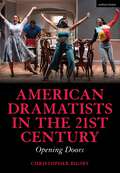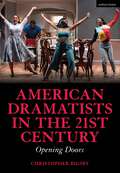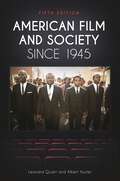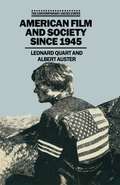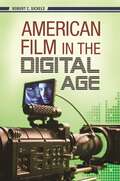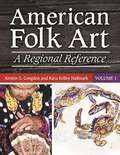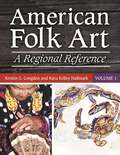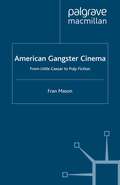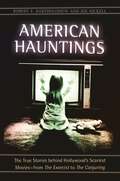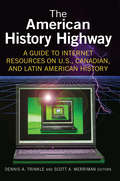- Table View
- List View
American Dramatists in the 21st Century: Opening Doors
by Christopher BigsbyIn American Dramatists in the 21st Century: Opening Doors, Christopher Bigsby examines the careers of seven award-winning playwrights: David Adjmi, Julia Cho, Jackie Sibblies Drury, Will Eno, Martyna Majok, Dominique Morisseau and Anna Ziegler. In addition to covering all their plays, including several as yet unpublished, he notes their critical reception while drawing on their own commentary on their approach to writing and the business of developing a career. The writers studied come from a diverse range of racial, religious and immigrant backgrounds. Five of the seven are women. Together, they open doors on a changing theatre and a changing America, as ever concerned with identity, both personal and national.This is the third in a series of books which, together, have explored the work of twenty-four American playwrights who have emerged in the current century.
American Dramatists in the 21st Century: Opening Doors
by Christopher BigsbyIn American Dramatists in the 21st Century: Opening Doors, Christopher Bigsby examines the careers of seven award-winning playwrights: David Adjmi, Julia Cho, Jackie Sibblies Drury, Will Eno, Martyna Majok, Dominique Morisseau and Anna Ziegler. In addition to covering all their plays, including several as yet unpublished, he notes their critical reception while drawing on their own commentary on their approach to writing and the business of developing a career. The writers studied come from a diverse range of racial, religious and immigrant backgrounds. Five of the seven are women. Together, they open doors on a changing theatre and a changing America, as ever concerned with identity, both personal and national.This is the third in a series of books which, together, have explored the work of twenty-four American playwrights who have emerged in the current century.
The American Dream and Contemporary Hollywood Cinema
by J. Emmett WinnWhile the myth of a classless America endures in the American Dream, the very stratification that it denies unfairly affects the majority of Americans. Study after study shows that it's increasingly difficult for working class people to achieve upward mobility in the US - so how does the American Dream continue to thrive? J. Emmett Winn shows us that the American Dream's continued glorification in contemporary Hollywood cinema should not be ignored. The book explicates three major themes surrounding the American Dream in contemporary Hollywood cinema and relates those findings to the United States' social and cultural changes in the last 25 years. Through his thoughtful analysis of films as diverse as Working Girl, Titanic, Pretty Woman, Flashdance, The Firm, Good Will Hunting, Saturday Night Fever, Wall Street and many others, Winn shows that contemporary Hollywood is very much in the business of keeping the Dream alive.
American Eccentric Cinema
by Dr Kim WilkinsSince the late 1990s a new language has emerged in film scholarship and criticism in response to the popularity of American directors such as Wes Anderson, Charlie Kaufman, and David O. Russell. Increasingly, adjectives like 'quirky', 'cute', and 'smart' are used to describe these American films, with a focus on their ironic (and sometimes deliberately comical) stories, character situations and tones. Kim Wilkins argues that, beyond the seemingly superficial descriptions, 'American eccentric cinema' presents a formal and thematic eccentricity that is distinct to the American context. She distinguishes these films from mainstream Hollywood cinema as they exhibit irregularities in characterization, tone, and setting, and deviate from established generic conventions. Each chapter builds a case for this position through detailed film analyses and comparisons to earlier American traditions, such as the New Hollywood cinema of the 1960s and 1970s. American Eccentric Cinema promises to challenge the notion of irony in American contemporary cinema, and questions the relationship of irony to a complex national and individual identity.
American Eccentric Cinema
by Kim WilkinsSince the late 1990s a new language has emerged in film scholarship and criticism in response to the popularity of American directors such as Wes Anderson, Charlie Kaufman, and David O. Russell. Increasingly, adjectives like 'quirky', 'cute', and 'smart' are used to describe these American films, with a focus on their ironic (and sometimes deliberately comical) stories, character situations and tones. Kim Wilkins argues that, beyond the seemingly superficial descriptions, 'American eccentric cinema' presents a formal and thematic eccentricity that is distinct to the American context. She distinguishes these films from mainstream Hollywood cinema as they exhibit irregularities in characterization, tone, and setting, and deviate from established generic conventions. Each chapter builds a case for this position through detailed film analyses and comparisons to earlier American traditions, such as the New Hollywood cinema of the 1960s and 1970s. American Eccentric Cinema promises to challenge the notion of irony in American contemporary cinema, and questions the relationship of irony to a complex national and individual identity.
American Film and Society since 1945
by Leonard Quart Albert AusterFrom Steven Spielberg's Lincoln to Clint Eastwood's American Sniper, this fifth edition of this classic film study text adds even more recent films and examines how these movies depict and represent the feelings and values of American society.One of the few authoritative books about American film and society, American Film and Society since 1945 combines accessible, fun-to-read text with a detailed, insightful, and scholarly political and social analysis that thoroughly explores the relationship of American film to society and provides essential historical context. The historical overview provides a "capsule analysis" of both American and Hollywood history for the most recent decade as well as past eras, in which topics like American realism; Vietnam, counterculture revolutions, and 1960s films; and Hollywood depictions of big business like Wall Street are covered. Readers will better understand the explicit and hidden meanings of films and appreciate the effects of the passion and personal engagement that viewers experience with films. This new edition prominently features a new chapter on American and Hollywood history from 2010 to 2017, giving readers an expanded examination of a breadth of culturally and socially important modern films that serves student research or pleasure reading. The coauthors have also included additional analysis of classic films such as To Kill a Mockingbird (1962) and A Face in the Crowd (1957).
American Film and Society since 1945
by Leonard Quart Albert AusterFrom Steven Spielberg's Lincoln to Clint Eastwood's American Sniper, this fifth edition of this classic film study text adds even more recent films and examines how these movies depict and represent the feelings and values of American society.One of the few authoritative books about American film and society, American Film and Society since 1945 combines accessible, fun-to-read text with a detailed, insightful, and scholarly political and social analysis that thoroughly explores the relationship of American film to society and provides essential historical context. The historical overview provides a "capsule analysis" of both American and Hollywood history for the most recent decade as well as past eras, in which topics like American realism; Vietnam, counterculture revolutions, and 1960s films; and Hollywood depictions of big business like Wall Street are covered. Readers will better understand the explicit and hidden meanings of films and appreciate the effects of the passion and personal engagement that viewers experience with films. This new edition prominently features a new chapter on American and Hollywood history from 2010 to 2017, giving readers an expanded examination of a breadth of culturally and socially important modern films that serves student research or pleasure reading. The coauthors have also included additional analysis of classic films such as To Kill a Mockingbird (1962) and A Face in the Crowd (1957).
American Film History: Selected Readings, 1960 to the Present
by Cynthia Lucia Roy Grundmann Art SimonFrom the American underground film to the blockbuster superhero, this authoritative collection of introductory and specialized readings explores the core issues and developments in American cinematic history during the second half of the twentieth-century through the present day. Considers essential subjects that have shaped the American film industry—from the impact of television and CGI to the rise of independent and underground film; from the impact of the civil rights, feminist and LGBT movements to that of 9/11. Features a student-friendly structure dividing coverage into the periods 1960-1975, 1976-1990, and 1991 to the present day, each of which opens with an historical overview Brings together a rich and varied selection of contributions by established film scholars, combining broad historical, social, and political contexts with detailed analysis of individual films, including Midnight Cowboy, Nashville, Cat Ballou, Chicago, Back to the Future, Killer of Sheep, Daughters of the Dust, Nothing But a Man, Ali, Easy Rider, The Conversation, The Texas Chain Saw Massacre, Longtime Companion, The Matrix, The War Tapes, the Batman films, and selected avant-garde and documentary films, among many others. Additional online resources, such as sample syllabi, which include suggested readings and filmographies, for both general and specialized courses, will be available online. May be used alongside American Film History: Selected Readings, Origins to 1960 to provide an authoritative study of American cinema from its earliest days through the new millennium
American Film History: Selected Readings, Origins to 1960
by Cynthia Lucia Roy Grundmann Art SimonThis authoritative collection of introductory and specialized readings explores the rich and innovative history of this period in American cinema. Spanning an essential range of subjects from the early 1900s Nickelodeon to the decline of the studio system in the 1960s, it combines a broad historical context with careful readings of individual films. Charts the rise of film in early twentieth-century America from its origins to 1960, exploring mainstream trends and developments, along with topics often relegated to the margins of standard film histories Covers diverse issues ranging from silent film and its iconic figures such as Charlie Chaplin, to the coming of sound and the rise of film genres, studio moguls, and, later, the Production Code and Cold War Blacklist Designed with both students and scholars in mind: each section opens with an historical overview and includes chapters that provide close, careful readings of individual films clustered around specific topics Accessibly structured by historical period, offering valuable cultural, social, and political contexts Contains careful, close analysis of key filmmakers and films from the era including D.W. Griffith, Charles Chaplin, Buster Keaton, Erich von Stroheim, Cecil B. DeMille, Don Juan, The Jazz Singer, I Am a Fugitive from a Chain Gang, Scarface, Red Dust, Glorifying the American Girl, Meet Me in St. Louis, Citizen Kane, Bambi, Frank Capra’s Why We Fight series, The Strange Love of Martha Ivers, Rebel Without a Cause, Force of Evil, and selected American avant-garde and underground films, among many others. Additional online resources such as sample syllabi, which include suggested readings and filmographies for both general specialized courses, will be available online. May be used alongside American Film History: Selected Readings, 1960 to the Present, to provide an authoritative study of American cinema through the new millennium
American Film History: Selected Readings, 1960 to the Present
by Cynthia Lucia Roy Grundmann Art SimonFrom the American underground film to the blockbuster superhero, this authoritative collection of introductory and specialized readings explores the core issues and developments in American cinematic history during the second half of the twentieth-century through the present day. Considers essential subjects that have shaped the American film industry—from the impact of television and CGI to the rise of independent and underground film; from the impact of the civil rights, feminist and LGBT movements to that of 9/11. Features a student-friendly structure dividing coverage into the periods 1960-1975, 1976-1990, and 1991 to the present day, each of which opens with an historical overview Brings together a rich and varied selection of contributions by established film scholars, combining broad historical, social, and political contexts with detailed analysis of individual films, including Midnight Cowboy, Nashville, Cat Ballou, Chicago, Back to the Future, Killer of Sheep, Daughters of the Dust, Nothing But a Man, Ali, Easy Rider, The Conversation, The Texas Chain Saw Massacre, Longtime Companion, The Matrix, The War Tapes, the Batman films, and selected avant-garde and documentary films, among many others. Additional online resources, such as sample syllabi, which include suggested readings and filmographies, for both general and specialized courses, will be available online. May be used alongside American Film History: Selected Readings, Origins to 1960 to provide an authoritative study of American cinema from its earliest days through the new millennium
American Film History: Selected Readings, Origins to 1960
by Cynthia Lucia Roy Grundmann Art SimonThis authoritative collection of introductory and specialized readings explores the rich and innovative history of this period in American cinema. Spanning an essential range of subjects from the early 1900s Nickelodeon to the decline of the studio system in the 1960s, it combines a broad historical context with careful readings of individual films. Charts the rise of film in early twentieth-century America from its origins to 1960, exploring mainstream trends and developments, along with topics often relegated to the margins of standard film histories Covers diverse issues ranging from silent film and its iconic figures such as Charlie Chaplin, to the coming of sound and the rise of film genres, studio moguls, and, later, the Production Code and Cold War Blacklist Designed with both students and scholars in mind: each section opens with an historical overview and includes chapters that provide close, careful readings of individual films clustered around specific topics Accessibly structured by historical period, offering valuable cultural, social, and political contexts Contains careful, close analysis of key filmmakers and films from the era including D.W. Griffith, Charles Chaplin, Buster Keaton, Erich von Stroheim, Cecil B. DeMille, Don Juan, The Jazz Singer, I Am a Fugitive from a Chain Gang, Scarface, Red Dust, Glorifying the American Girl, Meet Me in St. Louis, Citizen Kane, Bambi, Frank Capra’s Why We Fight series, The Strange Love of Martha Ivers, Rebel Without a Cause, Force of Evil, and selected American avant-garde and underground films, among many others. Additional online resources such as sample syllabi, which include suggested readings and filmographies for both general specialized courses, will be available online. May be used alongside American Film History: Selected Readings, 1960 to the Present, to provide an authoritative study of American cinema through the new millennium
American Film in the Digital Age (New Directions in Media)
by Robert C. SickelsThis eclectic, yet comprehensive analytical overview of the cataclysmic changes in the American film industry since 1990 shows how they have collectively resulted in a new era—The Digital Age.The American film industry has entered a new era. American Film in the Digital Age traces the industrial changes since 1990 that have brought us to this point, namely: the rise of media conglomerates, the proliferation of pornography through peripheral avenues of mainstream media, the role of star actors and directors in distributing and publicizing their own pet projects, the development of digital technology, and the death of truly independent films. Author Robert Sickels draws straight lines from the movies to music, DVDs, video games, fast food, digital-on-demand, and more, to demonstrate how all forms of media are merging into one. He explores the irony that the success of independent films essentially killed independent cinema, showing how it has become almost impossible to get a film released without the imprimatur of one of the big six media companies—Fox, Viacom, TimeWarner, Disney, General Electric, or CBS. In the end, using recent, popular films as examples, he explains not only how we got where we are, but where we're likely headed as well.
American Film in the Digital Age (New Directions in Media)
by Robert C. SickelsThis eclectic, yet comprehensive analytical overview of the cataclysmic changes in the American film industry since 1990 shows how they have collectively resulted in a new era—The Digital Age.The American film industry has entered a new era. American Film in the Digital Age traces the industrial changes since 1990 that have brought us to this point, namely: the rise of media conglomerates, the proliferation of pornography through peripheral avenues of mainstream media, the role of star actors and directors in distributing and publicizing their own pet projects, the development of digital technology, and the death of truly independent films. Author Robert Sickels draws straight lines from the movies to music, DVDs, video games, fast food, digital-on-demand, and more, to demonstrate how all forms of media are merging into one. He explores the irony that the success of independent films essentially killed independent cinema, showing how it has become almost impossible to get a film released without the imprimatur of one of the big six media companies—Fox, Viacom, TimeWarner, Disney, General Electric, or CBS. In the end, using recent, popular films as examples, he explains not only how we got where we are, but where we're likely headed as well.
American Film Satire in the 1990s: Hollywood Subversion
by J. NilssonThis study examines how a particular selection of films turned American cultural material of the 1990s into satirical experiences for viewers and finds that there are elements of resistance to norms and conventions in politics, to mainstream news channels and Hollywood, and to official American history already embedded in the culture.
American Folk Art [2 volumes]: A Regional Reference [2 volumes]
by Kristin G. Congdon Kara Kelley HallmarkFolk art is as varied as it is indicative of person and place, informed by innovation and grounded in cultural context. The variety and versatility of 300 American folk artists is captured in this collection of informative and thoroughly engaging essays.American Folk Art: A Regional Reference offers a collection of fascinating essays on the life and work of 300 individual artists. Some of the men and women profiled in these two volumes are well known, while others are important practitioners who have yet to receive the notice they merit. Because many of the artists in both categories have a clear identity with their land and culture, the work is organized by geographical region and includes an essay on each region to help make connections visible. There is also an introductory essay on U.S. folk art as a whole.Those writing about folk art to date tend to view each artist as either traditional or innovative. One of the major contributions of this work is that it demonstrates that folk artists more often exhibit both traits; they are grounded in their cultural context and creative in the way they make work their own. Such insights expand the study of folk art even as they readjust readers' understanding of who folk artists are.
American Folk Art [2 volumes]: A Regional Reference [2 volumes]
by Kristin G. Congdon Kara Kelley HallmarkFolk art is as varied as it is indicative of person and place, informed by innovation and grounded in cultural context. The variety and versatility of 300 American folk artists is captured in this collection of informative and thoroughly engaging essays.American Folk Art: A Regional Reference offers a collection of fascinating essays on the life and work of 300 individual artists. Some of the men and women profiled in these two volumes are well known, while others are important practitioners who have yet to receive the notice they merit. Because many of the artists in both categories have a clear identity with their land and culture, the work is organized by geographical region and includes an essay on each region to help make connections visible. There is also an introductory essay on U.S. folk art as a whole.Those writing about folk art to date tend to view each artist as either traditional or innovative. One of the major contributions of this work is that it demonstrates that folk artists more often exhibit both traits; they are grounded in their cultural context and creative in the way they make work their own. Such insights expand the study of folk art even as they readjust readers' understanding of who folk artists are.
American Gangster Cinema: From "Little Caesar" to "Pulp Fiction" (Crime Files)
by F. MasonMuch analysis of gangster movies has been based upon a study of the gangster as a malign figuration of the American Dream, originally set in the era of the Depression. This text extends previous analysis of the genre by examining the evolution of gangster movies from the 1930s to the contemporary period and by placing them in the context of cultural and cinematic issues such as masculinity, consumerism and technology. With a close examination of many films from Scarface and Public Enemy to Reservoir Dogs and Pulp Fiction , this book provides a fascinating insight into a topical and popular subject.
American Graphic: Disgust and Data in Contemporary Literature (Post*45)
by Rebecca B. ClarkWhat do we really mean when we call something "graphic"? In American Graphic, Rebecca Clark examines the "graphic" as a term tellingly at odds with itself. On the one hand, it seems to evoke the grotesque; on the other hand, it promises the geometrically streamlined in the form of graphs, diagrams, and user interfaces. Clark's innovation is to ask what happens when the same moment in a work of literature is graphic in both ways at once. Her answer suggests the graphic turn in contemporary literature is intimately implicated in the fraught dynamics of identification. As Clark reveals, this double graphic indexes the unseemliness of a lust—in our current culture of information—for cool epistemological mastery over the bodies of others. Clark analyzes the contemporary graphic along three specific axes: the ethnographic, the pornographic, and the infographic. In each chapter, Clark's explication of the double graphic reads a canonical author against literary, visual and/or performance works by Black and/or female creators. Pairing works by Edgar Allan Poe, Vladimir Nabokov, and Thomas Pynchon with pieces by Mat Johnson, Kara Walker, Fran Ross, Narcissister, and Teju Cole, Clark tests the effects and affects of the double graphic across racialized and gendered axes of differences. American Graphic forces us to face how closely and uncomfortably yoked together disgust and data have become in our increasingly graph-ick world.
American Graphic: Disgust and Data in Contemporary Literature (Post*45)
by Rebecca B. ClarkWhat do we really mean when we call something "graphic"? In American Graphic, Rebecca Clark examines the "graphic" as a term tellingly at odds with itself. On the one hand, it seems to evoke the grotesque; on the other hand, it promises the geometrically streamlined in the form of graphs, diagrams, and user interfaces. Clark's innovation is to ask what happens when the same moment in a work of literature is graphic in both ways at once. Her answer suggests the graphic turn in contemporary literature is intimately implicated in the fraught dynamics of identification. As Clark reveals, this double graphic indexes the unseemliness of a lust—in our current culture of information—for cool epistemological mastery over the bodies of others. Clark analyzes the contemporary graphic along three specific axes: the ethnographic, the pornographic, and the infographic. In each chapter, Clark's explication of the double graphic reads a canonical author against literary, visual and/or performance works by Black and/or female creators. Pairing works by Edgar Allan Poe, Vladimir Nabokov, and Thomas Pynchon with pieces by Mat Johnson, Kara Walker, Fran Ross, Narcissister, and Teju Cole, Clark tests the effects and affects of the double graphic across racialized and gendered axes of differences. American Graphic forces us to face how closely and uncomfortably yoked together disgust and data have become in our increasingly graph-ick world.
American Hauntings: The True Stories behind Hollywood's Scariest Movies—from The Exorcist to The Conjuring
by Robert E. Bartholomew Joe NickellThis work provides an accurate, in-depth examination and scientific evaluation of the most famous hauntings in American history as depicted in popular films and television programs.Neither a debunking book nor one written for the "true believer" in the paranormal, American Hauntings objectively scrutinizes the historic evidence behind such hugely popular films as The Exorcist, The Amityville Horror, An American Haunting, The Conjuring, and The Haunting in Connecticut to ascertain the accuracy of these entertainment depictions of "true life" hauntings. The authors then compare these popular culture accounts against the alleged real-life encounters and impartially weigh the evidence to assess whether each incident actually took place.Written by highly credentialed, recognized authorities on the paranormal and social psychology, this book contains meticulously documented, science-based information written for a broad audience, from middle and high school students and those taking introductory courses at a university level to general readers. There is no other work that provides as careful and unbiased an evaluation of the most famous hauntings in American history. The book also examines the reliability of popular television shows such as Unsolved Mysteries and Paranormal Witness.
American Hauntings: The True Stories behind Hollywood's Scariest Movies—from The Exorcist to The Conjuring
by Robert E. Bartholomew Joe NickellThis work provides an accurate, in-depth examination and scientific evaluation of the most famous hauntings in American history as depicted in popular films and television programs.Neither a debunking book nor one written for the "true believer" in the paranormal, American Hauntings objectively scrutinizes the historic evidence behind such hugely popular films as The Exorcist, The Amityville Horror, An American Haunting, The Conjuring, and The Haunting in Connecticut to ascertain the accuracy of these entertainment depictions of "true life" hauntings. The authors then compare these popular culture accounts against the alleged real-life encounters and impartially weigh the evidence to assess whether each incident actually took place.Written by highly credentialed, recognized authorities on the paranormal and social psychology, this book contains meticulously documented, science-based information written for a broad audience, from middle and high school students and those taking introductory courses at a university level to general readers. There is no other work that provides as careful and unbiased an evaluation of the most famous hauntings in American history. The book also examines the reliability of popular television shows such as Unsolved Mysteries and Paranormal Witness.
American History/American Film: Interpreting the Hollywood Image (Film Studies: Bloomsbury Academic Collections)
by John E. O'Connor Martin A. JacksonIn this pioneering work, sixteen historians analyse individual films for deeper insight into US institutions, values and lifestyles. Linking all of the essays is the belief that film holds much of value for the historian seeking to understand and interpret American history and culture. This title will be equally valuable for students and scholars in history using film for analysis as well as film students and scholars exploring the way social and historical circumstances are reflected and represented in film.
The American History Highway: A Guide to Internet Resources on U.S., Canadian, and Latin American History
by Dennis A. TrinkleThis brand new addition to the acclaimed "History Highway" series is essential for anyone conducting historical research on North, Central, or South America. Complete with a CD with live links to sites, it directs users to the best and broadest, most current information on U.S., Canadian, and Latin American history available on the Internet. "The American History Highway": provides detailed, easy-to-use information on more than 1,700 websites; covers all periods of U.S., Canadian, and Latin American History; features new coverage of Hispanic American and Asian American History; includes chapters on environmental history, immigration history, and document collections; all site information is current and up-to-date; includes a CD of the entire contents with live links to sites - just install the disc, go online, and link directly to the sites; and, also provides a practical introduction to web-based research for students and history buffs of all ages.
The American History Highway: A Guide to Internet Resources on U.S., Canadian, and Latin American History (History Highway Ser.)
by Dennis A. TrinkleThis brand new addition to the acclaimed "History Highway" series is essential for anyone conducting historical research on North, Central, or South America. Complete with a CD with live links to sites, it directs users to the best and broadest, most current information on U.S., Canadian, and Latin American history available on the Internet. "The American History Highway": provides detailed, easy-to-use information on more than 1,700 websites; covers all periods of U.S., Canadian, and Latin American History; features new coverage of Hispanic American and Asian American History; includes chapters on environmental history, immigration history, and document collections; all site information is current and up-to-date; includes a CD of the entire contents with live links to sites - just install the disc, go online, and link directly to the sites; and, also provides a practical introduction to web-based research for students and history buffs of all ages.
